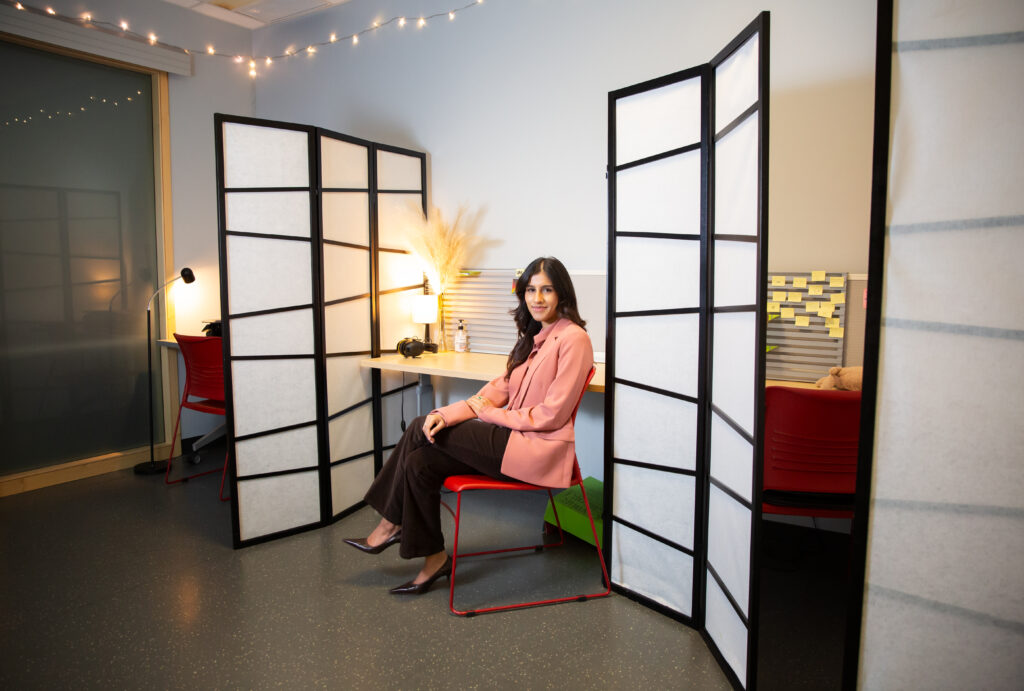Written by Jennifer Allford
Bushra Hashim likes to have a couple of plants in her home office — even though she often forgets to water them — and an extra-large computer screen. The plants provide access to nature — a form of biophilic design that is well-known to improve performance, while the big screen helps with her focus and poor vision, says the adaptive design specialist and University of Calgary alum.
Hashim, BA’18, MArch’20, who graduates with a Master of Environmental Design this spring, specializes in the design of mind-friendly environments, like workspaces that improve focus, judgment and executive functioning for people who are otherwise sensitive to their environment, including neurominorities such as those with autism and attention deficit hyperactivity disorder (ADHD).
“At least 15 to 20 per cent of the population is neurodivergent,” she says. “This is a significant minority given the prevalence and extent of overlap between experiences and under-diagnosis of girls and women.”
But designing spaces for diverse neurological experiences results in better space for everyone — mind-friendly design is just good design, Hashim says. “Our brain has a certain capacity — about five per cent — to process information consciously. Mind-friendly design recognizes this and aims to create spaces that subconsciously support our cognitive abilities—such as reasoning, memory, and organization—alongside our physical abilities, such as perceiving depth and regulating body temperature.”
Hashim teaches a class on neurodiversity and design at UCalgary’s School of Architecture, Planning and Landscape and became interested in the topic after her first experience working on a space for adults with intellectual disabilities—a sensory garden. She received her own diagnosis while studying for her Master of Environmental Design.
“The diagnosis allowed for self-compassion to come in,” she says. “Now I know what I need and how I can better support myself. But that kind of change needs to happen equally externally in our culture, in our workspaces and in our societies. And I think that’s starting to happen.”
The COVID-19 pandemic helped kick-start the growing movement for mind-friendly design. When much of the workforce was sent home, many had the opportunity to tailor their workspaces. “During COVID, you were able to set up your home office to suit your individual needs, so it was very comfortable for you,” says Hashim. “Returning back to the office, people are experiencing drastic differences, now more aware of the importance of a comfortable workspace.”
Partly to attract people back to the office, more employers are moving away from the standard grey cubicle to include mind-friendly features such as sensory zoning, natural light, and greenery, minimizing collective clutter, creating different types of spaces, and giving employees some control over temperature and sound. Hashim says having individual control is key — whether it be the light you place on the corner of the desk, or the sweater you leave on the chair to throw on when the AC kicks in.
Noting a study published in Nature, Hashim says “Women need approximately two degrees more of warmth than men to feel comfortable. Thermal control can be difficult because we all have our different preferences.” With smart thermostats and zoned HVAC systems, controlling the temperature is becoming more sophisticated than putting on, or taking off, that sweater.

Employees need places to meet and brainstorm at work, but equally imperative to “collaborative zones” are the “quiet zones” where you can close the door, shut out the noise and really concentrate. “Acoustics is usually a big problem — it’s loud, voices are echoing, there’s noise from building systems or traffic from clients or customers coming in, et cetera,” Hashim says. “Acoustic control is one of those things that has become really important for me.”
With that in mind, how can individuals improve our workspaces?
Hashim says employees can think back to their home office with its personal touches, tech, lighting or plants. “Start there,” says Hashim. “What were some of the things you added to your home office to make it more comfortable for you?” While making a space your own is more difficult with “hot desking” — a practice used in some offices that sees employees using different spaces on different days — she suggests a balance between personal and collective needs.
“Workplace design should be able to provide variety, choice and control,” says Hashim. “It’s difficult to know the balance because some people are hyposensitive, as in they seek stimulation from their environments, and some people are hypersensitive, as in they get overstimulated in their environments. An office with a diverse range of work environments immediately acknowledges that we all have different needs, and one size doesn’t fit all.”
While the notion of “one size fits all” hasn’t been entirely debunked, Hashim is pleased to see growing recognition of the need for different types of spaces. In fact, organizations such as the Rick Hansen Foundation (where Hashim serves as a member of the technical subcommittee) have created a mind-friendly design category for buildings to qualify for accessibility certification.
And regardless of how your particular brain works, a workspace designed with neurodiversity in mind will be a better workspace for all. “What needs to be debunked is this idea of universal design or inclusive design being one single solution that works perfectly for everyone,” says Hashim. “Having a variety of spaces, adaptable spaces, is what’s important to consider now.”




